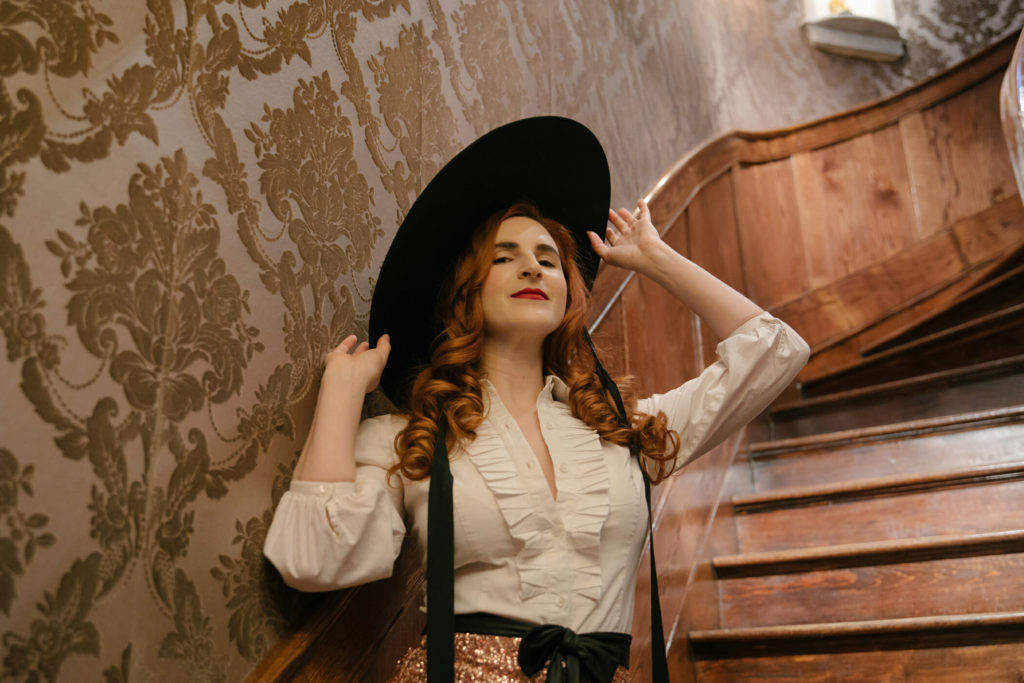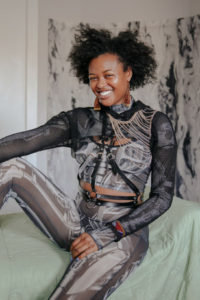
Image by Makeda Sandford. Taken at my home: Hacienda Villa in Bushwick, Brooklyn. January 2020

The first time I heard the term “sex positive” was in 2017. I was having drinks with a close girlfriend when we began divulging some of our kinks. As the conversation got louder, funnier, and more x-rated, she suggested I join “Sex Positive Universe for Womxn,” a Facebook group and dedicated safe space founded by sexuality doula Isabella Frappier. “It’s kind of beautiful,” my friend said. “Women ask questions about dating, share lingerie brands, swap gynecologist recommendations…. You’ll love it.”
She was right. After I was accepted (joining required filling out a brief and straightforward form), I spent hours scrolling through the myriad comments, pictures, and questions from fellow members. People asked about alternative birth control methods, shared favorite sex toys, and posted pictures of themselves on “Feelin’ Your Selfie Friday.” It was the estrogen-filled refuge I didn’t know I needed. The repressed 13-year-old in me was finally vindicated.
As a teen, I begged my friends to share their first-kiss stories, and was the first to instigate games of “Never Have I Ever.” I once swapped out the Madeline VHS for American Pie at a Blockbuster so that I could watch the infamous pie sex scene after my parents had gone to bed. My copy of White Oleander was worn and tattered from how often I read the chapter where Astrid loses her virginity. Like many teenagers, sex was my private obsession. Eventually I realized the majority of my friends were also interested in sex—and, like me, they just felt awkward and stupid talking about it.

Tiana Peters is one of the people challenging the old guard. As a self-described “conscious hedonist,” she’s dedicated to destigmatizing alternative lifestyles.
The term “sex positive” was first attributed to a controversial doctor named Wilhelm Riech who, in the 1930s, posited that “some societies view sexual expression as essentially good and healthy, while others have a generally negative view of sexuality and seek to repress and control libido.” (You can guess where Americans netted out back then.) Over the next 90 years, his ideas would be adapted and reinterpretted through many cultural movements, like the sexual revolution of the ’60s and each wave of feminism. But mainstream attitudes around sex have lagged behind, making teens like me feel like freaks for having normal sexual curiosity as recently as the 2010s.
When I joined Frappier’s Facebook group and started paying more attention to the work being done to change the conversation, a newer, more modern definition of sex positivity emerged for me. With the progress made in the LGBTQ space, a broadening scope of sexual expression and gender identity, and some much needed conversations regarding consent and harassment, mainstream attitudes toward sex are becoming increasingly open and fluid. A lot has happened since I watched Allison Hannigan detail her adventures at band camp (which I was actually kind of into), and even more is happening now. Below, some of the forces shaping the future of sex positivity.
Sex-ed but without the bananas (unless you’re into that)
One of the reasons my friends and I were so hesistant to talk about sex is because we grew up with a sex education that was either lacking critical information or steeped in stigma. Inside the classroom, we learned about prophylactics and reproductive organs, and outside of the classroom, the conversation was clouded with patriarchal and heterosexual norms our young minds couldn’t parse. I ignored my first girl crush because I had historically liked boys and hadn’t registered that bisexuality was an option. Many of my girlfriends and I were persuaded into our first sexual experiences. We knew about condoms but we didn’t understand consent, sexual expression, or self-love.
But modern sex education is getting a queer-friendly and comprehensive makeover. California initiatives like Informed and In Charge and Teen Talk provide schools with curriculums focused on respect, discovery, sexual orientation, gender expression, and qualities of healthy relationships—all things my 13-year-old self (and all kids of my generation) could have seriously benefited from. And where structural solutions lack, a generation of YouTubers have cropped up to fill the gaps. (If you click that link prepare to lose a couple hours.)

“Sex positivity asserts that we deserve to make our sexual choices without fear of repercussions,” says Lila Donnolo, the creator and host of the 5-star rated horizontal with lila, which broadcasts intimate conversations recorded while lying down.
Sex ed 2.0 isn’t just for kids, either. At 29, I find myself learning the things I once yearned to know, this time through podcasts (The Ersties Podcast and Horizontal with Lila), Instagram accounts (Raquel Savage), and Facebook groups. The conversation is about more than just products and pleasure—it’s about treating and having open discussions surrounding sexual health (like STIs, endometriosis, PCOS), declining sex drives, or sexual trauma. Sexual embodiment programs, like that of Cara Kovacs, are dedicated to helping clients reclaim ownership over their sexuality. Much of Kovac’s work focuses on changing any limiting sexual beliefs a client might be subconsciously latching onto.
“Many of us don’t have a positive relationship with our bodies, or we think that something about our body is not normal or good enough,” Kovacs tells me. “The basis for this narrative is the whole ‘I’m not worthy of love’ idea, and we can change that.”
Everyone’s talking about sex, and it feels good
Because our education is expanding, it’s becoming easier and more common to have casual conversations about sex. This can be especially powerful when it seeps into public discourse; when I saw The Incendiaries author R.O. Kwan come out as bisexual via Twitter and Dan Levy explain that he liked “the wine, not the label” on Schitt’s Creek, I felt my own vocabulary, and thus my identity, expanding.
“When we have words for something, we can conceptualize it, and if we can conceptualize it, then we know there are possibilities beyond the ones we’ve been taught by church or family,” says Lila Donnolo, host of the podcast Horizontal With Lila. “So the fact that words like nonbinary and genderqueer and nonmonogamous relationship and pansexual are showing up in our media, on our streaming TV shows, in the mouths of actors and celebrities and Instagram stars, that means more and more people are being made aware.”
In other words: When we watch Orlando Bloom and Malin Akerman’s adorably awkward attempt at a threesome in Easy, it makes it easier to imagine the same for ourselves.

Katie Bianchi is a member of the Shrill Collective production team, a theatre company dedicated to giving female and non-bianary voices a platform to share their artistic perspectives. “Sex positivity is a radical action,” she says. “Accept your sexual desires and those of others, practice consent, and remember that you’re not alone out here, you’ve just got to find your people.”
“It can be very frightening to talk to your partner about what you want, but it’s also deeply freeing,” says Sean Grady, who is engaged to his partner of nine years. “Our version of sex positivity looks like talking about what we want without shame and making space for each other to do so as well.” Like many, Sean and his boyfriend have reexamined their definition of monogamy. And while the tenets of sex positivity don’t require a break with tradition, they do entail partners discussing their sexuality without fear or judgement, and allowing for diverse approaches to sexual fulfillment.
Enter: the cuddle puddle
As sex talk reaches new realms, organizers have responded—by starting communities, founding programs, and throwing parties that don’t look like their forebearers. The iconic Palm Springs swinging scene is probably still thriving (more power to it), but I’m talking about events specifically focused on sensuality, connection, and consensual experimentation. Many of these events don’t require any intercourse or nudity at all: Shibari (or Japanese rope play) workshops at the Hacienda Studio in New York City and Cuddle Puddles in San Francisco focus on sensuality and intimate connection over sex. Hacienda also offers pool parties and socials where guests can simply get to know other like-minded individuals without the added pressure of trying to make something happen.

Sex activist Tiana Peters says owning your sexuality comes in many forms: “Knowing your sexual health status, having open honest dialogue about desires in and out of the bedroom, and understanding and practicing consent—especially exercising your right to say no.”
“People are searching for spaces to feel vulnerable without judgement,” says Tiana Peters, an event host and activist in the sex-positive community. “That’s only going to continue as more curious people join the community or create their own.”
“It truly is a Goldilocks game,” adds Bianchi, who has attended events at Bound NYC and Hacienda Studio. “So many people are doing the same things we are, trying to figure themselves out and feel free, and it’s not always the people you’d expect.”
These communities aren’t just inclusive—they’re spearheaded by queer folks, POC, and women. It’s a refreshing change from the soul-sucking how-to-drive-him-wild perspective so many of us grew used to as confused tweens. In that way, the sex-positive movement has become a political force, encouraging people claim ownership of their sexuality instead of letting others define it.
“In order for women and queer people to feel safe expressing themselves sexually, we need straight men to be on board and acknowledge where we’re coming from historically,” Bianchi notes. “They’re absolutely vital allies, but women and the queer community are having moments right now.”
Kovacs describes this era as a reclamation of the divine feminine, or, in less woo woo terms: the idea of leading from a place of softness, emotional honesty, and having tough conversations with an open mind. This is one of the things that made me fall in love with Sex Postive Women of the Universe back in 2017; the interactions felt as though they were symobolic of a larger shift in our cultural landscape, one that is heading towards compassion and curiosity. It’s also what I’m most excited for in 2020: a broader, more inclusive conversation that untangles shame and allows us to explore our authentic selves, even if we’re still learning what that looks like.
Photos by Makeda Sandford.
